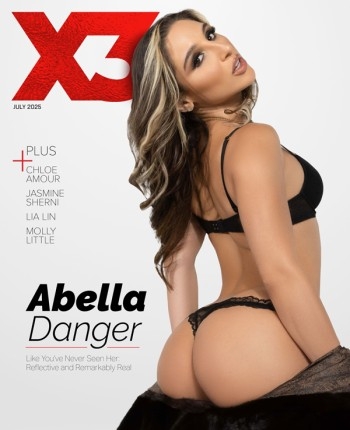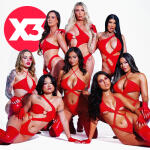Take Bud Lee. The arc of his career can be plotted with the credits listed at IMDb.com, the Internet Movie Database: a handful of crew gigs, a half-dozen screenplays, more than a dozen turns as producer or executive producer, a score of acting credits and 120-plus films directed since 1985. Add in marriages to Hyapatia Lee and Asia Carrera during that 20-year span, and you can easily see that Lee paid his dues. But he's never gotten the blues, even after three failed marriages.
"I want to be challenged in a relationship," Lee says, adding that he remains "open to the possibility" of another relationship with a "strong, capable woman" in the biz.
With his wild mane of reddish-brown hair and a mostly-salt-with-some-pepper beard, Lee looks like a Highlands warrior cast for a "Braveheart" sequel, but in reality, he is a doting parent to two teenage sons. "Parenting is my responsibility," Lee says, "and I'm the one who has to keep them out of the medicine cabinet and the adult video store" until they reach legal age.
No fast-lane jet-setter, Lee is a down-to-earth, business-minded artist — the kind of director a studio loves to get hold of, and won't let go once it does. Playboy's Spice production company has Lee under contract now, and after a good cable run with "Spice Club" and "Spice Hotel," he and Playboy are working together on what he promises will be a "highly entertaining new show." The still unnamed cable show will be "sort of a magazine format, a 90-minute journey through adult movies," Lee confides, adding that beautiful, strong, charismatic women will be on hand to present news and features to the viewers. "This is a big, big deal," Lee says.
XBIZ spoke with Lee about both his direction and his directing, as well as the gear and gadgets he uses to bring his visions to the screen.
XBIZ: We usually start with the same question, Bud. Camera of choice?
BUD LEE: Sony [HDW] S900. Now, the F model may be more user-friendly, as a high-end consumer or "prosumer" model. For feature shooting, though, it's the S900. It's just a nice, solid camera.
XBIZ: The S900 is a high-definition 1080i model, the first that Sony introduced, back in 2000. It's well regarded for its onboard color control. You're a stickler for color, so how do you work with the unit to get what you want?
BL: The most important thing for getting the right look is lighting. This camera, like all the new digital film tools, really loves light. Good lighting enriches the picture. With a half-white Pro-Mist filter, you get a nice film-grain look. It does knock down the detail a bit, but that gets the look.
XBIZ: The Sony HDW line is made up of pretty hefty cameras. How do you manage all the tracking and motion shots?
BL: On the sets, of course, we have the porta-jibs and the dollies because it is a nice big camera, but my camera guys and I will throw it up on our shoulders if we need to.
XBIZ: Surely not for POV scenes, right?
BL: No, for POV shots, it's the Canon XL-H1, a prosumer model, another hi-def 1080i camera. It does have the MPEG2 compression, but it matches up well with what I'm shooting with the Sony. Canon has been making lenses forever, and the XL-H1's lens is a pretty decent glass lens, although some people complain about having a hard time with the viewfinder.
XBIZ: No matter what camera you use, eventually you will learn to get what you want, right?
BL: The most important thing about your camera of choice, of course, is what you put in front of the lens.
XBIZ: Words to live by, definitely. Now, stylistically, you don't seem to have gravitated toward that high-energy, quick-cut, frantic style — for example, in that recent Ridley Scott film.
BL: I saw that movie, "Domino," about Domino Harvey. I am more of a storyteller, so when I start a movie, I like to lay out the story visually and verbally. You know, like, here's what the characters are like, what they sound like, think, all that. I am really sophomoric with dialog and let the writers make the characters come to life with words, while I tell the story with pictures.
XBIZ: You must work closely with the writers, though, to be able to stay on the same wavelength. How is that done?
BL: Look, 65 to 75 percent of an adult movie is dialog free, so you have maybe 15 or 20 minutes for dialog to help bring the story to fruition. You have a back story and the history, in well-written and concise dialog, with nothing wasted.
XBIZ: Which brings us full circle, back to what you do with lighting and texture and camera position to advance the story, tell the tale and make the characters real enough to care about.
BL: The story and the emotions of the characters will set up what happens with the filming and determine the techniques. If the character is dark and lonely, then we go dark and lonely, you know?
XBIZ: So often, adult and mainstream films look like technique in search of scenes. With the proliferation of cheap DV camcorders and PCs for editing, what has happened to the artistic standard, in adult particularly?
BL: The cheap technology, the computers and DV cameras, brought a lot of new people into this business, gave a lot of people an opportunity to experiment with the art form. Ultimately, society is enriched by that. There are some great artists working in this industry, but you'll always have people pandering to the lowest common denominator, whether it's down and dirty or creamy and puffy.
XBIZ: We've talked directing, now let's talk direction. What direction is Bud Lee headed? Where are you going with this new cable show, with Spice and Playboy?
BL: I have a great relationship with my boss, the head of production, who's a real hands-on type, and with the principals of the company. The relationship is open and supportive. We're just about to release "The Sex Whisperer," a very big deal for us. Then, on the new TV show, we'll visit movie sets, even see what other companies are doing. It's a whole new direction, and very exciting.







